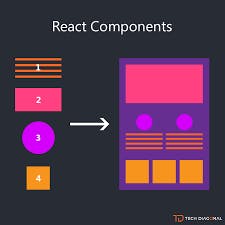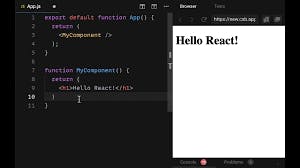The initial stage of learning React: Beginner-Friendly Guide
Development
TABLE OF CONTENT
Introduction
What is React?
Why use React?
React ecosystem overview
Types of Components
Understand React Component
Built Confidence
Conclusion
Introduction
What is React?
React is an open-source JavaScript library used for building user interfaces (UIs) and single-page applications. Developed and maintained by Facebook, it allows developers to create reusable UI components and manage states in a declarative way.
React operates on a virtual DOM (Document Object Model), which is a lightweight representation of the actual DOM in memory. When a user interacts with a React component, the virtual DOM updates and React efficiently update only the necessary parts of the actual DOM. This makes React fast and efficient, as it minimizes the number of DOM manipulations needed to update the UI.
React is often used in conjunction with other libraries and tools in the React ecosystem, like Redux for state management, React Router for navigation, and styled components for styling.
React is popular among developers for its efficiency, scalability, and versatility. It allows developers to create complex UIs with ease, and its component-based architecture encourages reusable code and clean code organization.
Overall, React is a powerful tool for building modern, interactive web applications.
Why use React?
There are several reasons why developers choose to use React for building web applications. Here are some of the main reasons:
Component-based architecture: React allows you to break down your user interface into smaller, reusable components. This makes your code easier to manage, test, and maintain, and it also allows you to reuse components across different parts of your application.
Efficient rendering: React uses a virtual DOM to update the UI efficiently. Instead of manipulating the actual DOM directly, React updates a lightweight copy of it in memory and then only updates the parts of the actual DOM that have changed. This makes React faster and more efficient than other traditional methods of updating the UI.
Large and active community: React has a large and active community of developers who contribute to the ecosystem by creating libraries, tools, and resources to make development faster and more efficient. This means that you can easily find help and support if you run into issues while using React.
Versatility: React can be used to build a variety of applications, from simple websites to complex, data-intensive web applications. React can also be used with other libraries and tools in the React ecosystem, like Redux, React Router and styled-components.
Performance: React is designed to be highly performant, with the ability to handle large amounts of data and complex user interfaces without slowing down the application. This makes React a good choice for building applications that need to be fast and responsive.
Overall, React is a powerful tool for building modern, interactive web applications, and it has become a popular choice for many developers because of its efficiency, scalability, versatility, and large community support.
- React ecosystem overview
React - React is a JavaScript library for building user interfaces. It allows you to create reusable UI components and manage the state in a declarative way.
React Native - React Native is a framework for building native mobile apps using React. It allows you to write code once and deploy it on multiple platforms, including iOS, Android, and the web.
Redux - Redux is a state management library that works well with React. It helps you predictably manage the state and can be used with any JavaScript framework.
React Router - React Router is a library that provides declarative routing for React applications. It allows you to map URLs to specific components and manage navigation in a declarative way.
Next.js - Next.js is a framework for building server-side rendered React applications. It provides many features out-of-the-box, including automatic code splitting, server-side rendering, and static site generation.
Gatsby - Gatsby is a static site generator that uses React for building websites. It allows you to build fast, modern websites with features like automatic image optimization, code splitting, and serverless functions.
Styled Components - Styled Component is a library that allows you to write CSS-in-JS in a declarative way. It makes it easy to create reusable styles and components that are encapsulated and maintainable.
React Bootstrap - React Bootstrap is a library that provides Bootstrap components for React applications. It allows you to easily create responsive and accessible UI components for your React app.
Material UI - Material UI is a library that provides Google's Material Design components for React. It allows you to create modern and beautiful UIs with a consistent look and feel.
React Testing Library - React Testing Library is a library that provides utilities for testing React components. It makes it easy to write tests that ensure your components behave as expected and are accessible to all users.
Types of Components
Types of components - Functional component and Class component

Functional component - Functional components are easier to understand as compared to class-based components. The functional component is just a simple javascript function; it accepts the data in the form of props and returns the react element. This simplicity makes it easier for developers to understand and write functional components, especially those who are new to React.Functional components don't use the "this" keyword, which can sometimes be confusing for developers who are not familiar with JavaScript's "this" behavior. Instead, functional components access props directly as function arguments. Functional components can be more performant than class components because they don't have the overhead of creating a class instance. This makes functional components a good choice for simple components that don't require state or lifecycle methods. With the introduction of Hooks in React 16.8, functional components gained the ability to manage state and lifecycle methods in a more concise and reusable way. Hooks like useState and use effect allow you to add state and lifecycle methods to functional components without having to use class components.
Class component - Class components use a different syntax than functional components, which can be more complex and difficult to understand, especially for beginners who are new to React. Class components have lifecycle methods, which can be difficult to understand and use correctly. These methods are called at specific points in a component's lifecycle, such as when it is mounted or updated. It can be challenging to know which lifecycle method to use and when. Class components use a different syntax for managing state than functional components. They require you to define the state in the constructor and to use the setState method to update the state, which can be more complex than using hooks in functional components. Class components can be less performant than functional components because they have the overhead of creating a class instance. This can slow down the rendering of components, especially when you have many instances of the same class component. While class components can be more complex than functional components, they are still an important part of React and are required for some advanced features like custom lifecycle methods and performance optimizations. However, if you are just starting with React or building simpler components, it may be easier and more efficient to use functional components instead.
here is the link to which you can refer -
" Note - Beginners can go with functional components and later they can explore class-based components. this will help them to boost confidence rather than getting confused "
Understand React Component
For understanding, functional components just make sure that you have a thorough understanding of hooks, stateless, props, and the render method.
Here is the link to which you can refer -
hooks - https://youtu.be/CvNvRaS3u60
props -https://youtu.be/GgurJ_3y0Jg
Now just for your faith, you can spend some time on the class component. just go through some concepts like the "this" keyword, what is the state? and syntax of the class component. after spending some time you will notice the difference between the functional component and the class-based component itself.
Built Confidence
By now you have learned many concepts like hooks, props, stateless, etc . now you can make some small beginner-friendly projects. one project I would like to suggest is "CART ITEM". This project will help you to understand the concepts more efficiently and boost your confidence. It will also help you to understand the crud operations of firebase.

here is the GitHub link that you can prefer -
Conclusion
These tips will help you to determine the correct route of learning to react. To become a pro in any domain first you must have the fundamentals crystal clear.
Thanks for reading,
See you in the next blog, Until then keep developing and solving..

